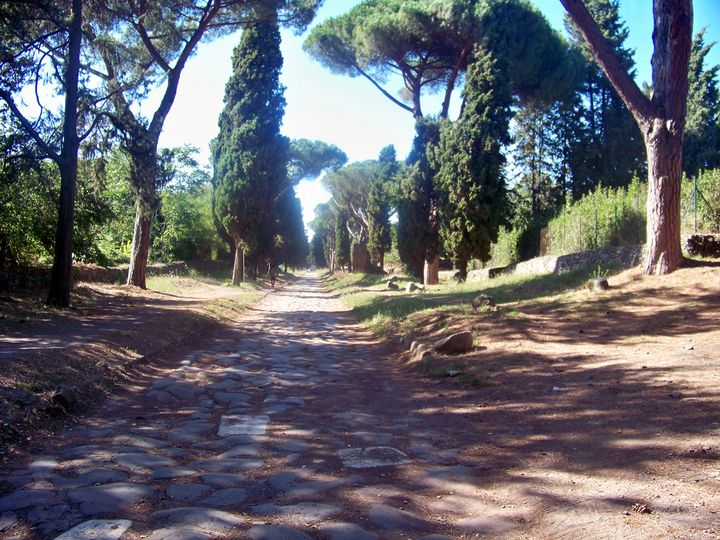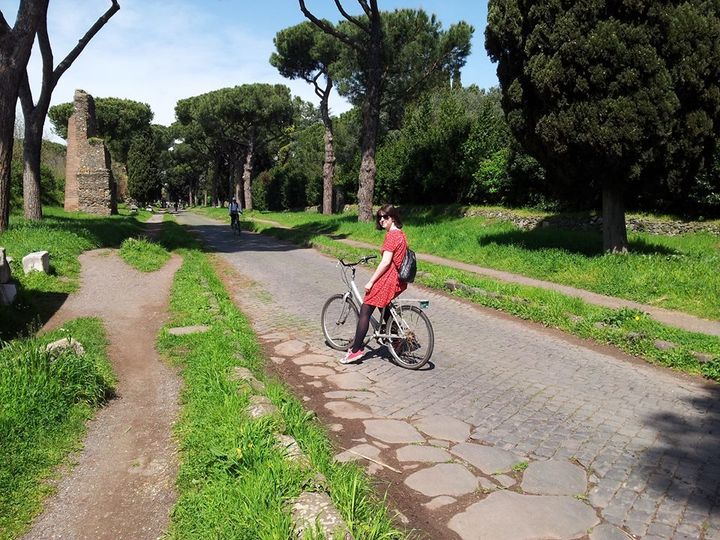
The Appian Way
Once you start travelling down the Appian Way, it’s very difficult to turn back. A few miles down the road, the people begin to disappear, and the city feels like a distant memory. As you walk beneath the shade of the cypresses, passing medieval towers and fragments of Roman statues, you seem to be travelling through a strange, enchanted place that exists somewhere between city and country, past and present. You can enjoy the illusion of living in the past, walking in the footsteps of Roman soldiers and emperors, until you suddenly reach a break in the road, and have to wait at the intersection for the cars to pass before you can cross to the other side, continuing your journey on timewarped cobblestones.
The Appian Way once stretched from Rome to Brindisi, and was referred to as “the queen of long roads”. Built in 312 BC, it was originally intended for the transportation of military troops and supplies, running in a straight line until it hit the coast, and then snaking its way across the south of Italy. Although many sections of the road have disappeared or been interrupted, it’s possible to follow the road for the first 10 miles, beginning at Porta San Sebastiano in the southeast of Rome.
I live in Rome, and trips along the Appian Way have become part of my weekend routine. On a Sunday morning I’ll often endure a tedious wait for the 118 bus, which has several stops along the beginning of the Appian Way. Then, more often than not, I’ll rent a bike and begin my ritualistic journey out of Rome, speeding past the shattered statues that watch over the ancient road.

Cycling on the Appian Way
For me, the Appian Way is the most magical place in Rome, perhaps because it’s not only a place, but a journey in itself. The road is lined with intriguing sights - the Catacombs of San Callisto, the Tomb of Caecilia Metella, the Villa dei Quintili - but it’s impossible to visit the Appian Way and restrict yourself to a single destination. After exploring the dark tunnels of the catacombs or clambering over the ruins of a Roman villa, all it takes is a glance down the road, and you’re compelled to continue, to see what lies beyond the tunnel of trees.
The Villa dei Quintili is my landmark. When I see the huge brick tombs on my left and catch a glimpse of the ruins across the field, I know where I am, and how far I’ve come. I’ll never forget my first visit to the villa, when I stumbled across it by accident on a hot May morning. I bought my ticket at the gate, from an old man who seemed to be half asleep, and strode through the long grass until I reached the sprawling ruins.
The villa belonged to two brothers, until the emperor Commodus had them killed, and took the house for himself. Now the only indication of the villa’s former luxury is its size - the walls are enormous, and the ruins are scattered across a large meadow - but a visit to the villa is still an evocative experience. On my first visit I had the place to myself, and could hardly believe that I was walking on the original floor of a Roman dining room, where Commodus had once hosted his banquets. Despite its deteriorated state - or perhaps because of it - the Villa dei Quintili is one of the most atmospheric places I’ve ever been to. When I stand on the mosaic floor of a ruined room and watch a plane fly overhead, the villa seems to be the perfect symbol of the spirit of the Appian Way - a remnant of an ancient past that lingers uneasily on the threshold of present.

Via dei Quintili
Once, during a misguided attempt to reach the Appian Way from the Parco degli Acquedotti (Park of the Aqueducts), I got hopelessly lost. I had to climb under a barbed wire fence, and narrowly missed getting hit by a car on a busy road before I finally reached found the Appian Way. Relieved to finally know where I was, I began the long walk back towards the centre of Rome. After about half an hour I recognised the familiar ruins of the Villa dei Quintili on my left, instead of my right, which meant that I was walking in the wrong direction. When you’re tired and disorientated, there are few things more dispiriting than seeing ruins on the wrong side of the road.
Getting lost on a straight road which I’d travelled down countless times before was not one of my finest moments, but the Appian Way can be strangely disorientating. Once you go beyond the villa and reach the sixth or seventh mile, people seem to vanish, and you’re left alone with the birds and the sheep. The most famous monuments on the Appian Way, which attract the majority of visitors, are dotted along the first five miles of the road. When you reach the sixth mile there’s only a 12th century tower, and the tombs and mausoleums of the nameless dead.
In Venice there’s a tiny alleyway named Calle dei Morti ( “Street of the Dead”). It would be an even more appropriate name for the Appian Way, which was once lined with the crucified bodies of Spartacus’s army - 6,000 crosses from Rome to Capua. Even today, reminders of death are everywhere. The Catacombs of San Callisto stretch for miles, and although the popes and martyrs have been transferred elsewhere, they still hold the bodies of hundreds of thousands of Romans. The vast fortress of the Tomb of Caecilia Metella honours the daughter of a Roman nobleman. Other mausoleums are marked by plaques and fragmented faces, or sit beneath farmhouses, or are nothing more than small hills by the roadside - unmarked, unnoticed, forgotten.
Even after repeated journeys down the Appian Way - slow walks and ecstatic bike rides - I’ve never made it beyond the seventh mile. I could blame the heat, or lack of time, or my anxiety about missing the bus back to Rome, but the real reason is that I’m reluctant to travel too far, and risk spoiling the illusion. The map suggests that within a couple more miles, the road comes dangerously close to Ciampino airport, and then gets swallowed up by suburbia. The Appian Way of my imagination has more in common with Piranesi’s Baroque fantasy than reality. I feel compelled to explore, but I’m also compelled to turn back before I go too far, because my Appian Way is a road that never ends.

The Appian Way by Piranesi
Alexandra Turney works for Through Eternity Tours and writes about life in Rome on her blog, Go Thou to Rome. Follow her on Instagram.
